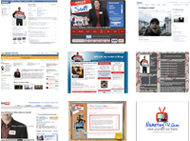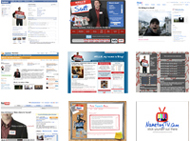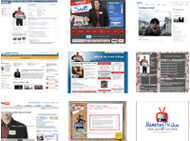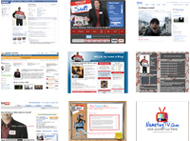 Artists.
Artists.
Authors.
Rockstars.
Cult leaders.
Presidential candidates.
American Idol contestants.
What do all these people have in common?
They’re all building a following.
HERE’S THE GOOD NEWS: so can you!
That’s the beauty (and ironically, sometimes the horror) of the Web: anyone with an idea can share it with the world and build a following around it. And they can do so quickly, powerfully and through a variety of media.
Unfortunately, the idea of “building a following” may sound too grandiose, too celebrity-ish and too impossible to the average businessperson.
“Who am I to build a following?” you think.
Wrong question.
Instead, ask yourself, “Am I being selfish with my knowledge?”
See, the dictionary defines a following as, “A group of people who admire or support somebody or something over a period of time.”
OK. Couple of key points in that definition:
FIRST: “A group of people.”
That doesn’t mean millions, thousands, or even hundreds. Don’t be intimidated by a false necessity to accumulate hordes of followers.
SECOND: “…admire or support…”
That doesn’t mean people are bowing down to you. Building a following isn’t about ego; it’s about shared values and mutual goals.
THIRD: “…somebody or something…”
That doesn’t mean it’s all about one person. It’s about an idea, a value, a movement, a cause and a vision.
FOURTH: “…over a period of time.”
That doesn’t mean you’re a fad, a trend, a hot topic or the new flavor of the month. You build a following one person at a time.
Actually, wait. That last point was wrong.
I shouldn’t have said, “one person at a time.”
I should have said, “one FAN at a time.”
Because that’s what building a following is about: loyalty.
Not just to you, but to the bigger idea.
So, if you want to get started (or continue) building a following, remember three key ideas:
1.Writing is the Basis of All Wealth
You can’t build a following around an idea if you haven’t first expanded, explored and clarified it on paper. Even if you don’t consider yourself a writer, penning your thoughts is the single greatest starting point for building a following.
ASK YOURSELF THIS: If everybody did exactly what I said, what would the world look like?
This question will help you build a template for your philosophy.
AND REMEMBER THIS: Guy Kawasaki, an author/entrepreneur with an incredible following said, “It’s impossible to build community around mediocre writing.”
The more you write, the quicker you uncover your unique VOICE.
2. Fanagement
You can’t build a following without fans. The challenge, then, is creating, maintaining and staying in front of them. Here a few suggestions:
*Ask for their email. The crux of permission marketing is to get your fans to opt-in. Be sure you’re regularly asking new people in person AND online. Now, while giving someone your email address is technically “free,” there’s still the concern of getting spammed. So, be certain people understand your intentions at the onset. Respect always wins.
*Consistently deliver a value message. Whether it’s through an ezine, podcast or blog, you MUST deliver value. Remind your fans WHY they follow you. Also, ask for their input, ideas, feedback and comments. REMEMBER: the more involved they are, the more ownership they take. The more ownership they take, the more people they tell. And the more people they tell, the bigger your following grows.
*Gratitude. Because a following is nothing with out followers, make sure you regularly remind them how much you value their loyalty.
3. Be Approachable
Lastly, members (and potential members) of your following MUST have access to you and your ideas. In order to project approachability, remember these ABC’s:
*Access. Make yourself accessible through several media, i.e., email, phone and instant messenger. See, each of your fans maintains a different communication style. So it’s valuable to offer them several contact options. REMEMBER: If someone can’t come up to you, how will they ever get behind you?
*Boundaries. On the flip side, set realistic expectations and personal policies for the accessibility of your time and information. Every “yes” to one thing is a “no” to another.
*Content. Since you’re writing regularly now (right?) you need to make your content accessible for reading, downloading and sharing. This is ESSENTIAL for building a following. Post your ideas on a blog, website, even on public article databases. (NOTE: if you’re concerned about piracy, relax. Just be sure to write in a voice that is SO unique to you, that you become SO identified with; that someone wouldn’t dare steal it. And if he did, people would know it.)
THE BOTTOM LINE: building a following is not an easy task.
It doesn’t happen overnight.
It doesn’t happen without work.
It doesn’t happen without consistency.
However.
If you regularly deliver value through writing…
If you create a fanagement system for your followers…
If you maintain approachability within your own boundaries…
Then you WILL create a group of people who admire or support you and your ideas.
Even if you’re not a cult leader.
LET ME ASK YA THIS…
Are you building a following?
LET ME SUGGEST THIS…
Share your best Fanagement Techniques here!
* * * *
Scott Ginsberg
That Guy with the Nametag
 Are you a friend of The Nametag Network?
Are you a friend of The Nametag Network?
Read more blogs!
Rent Scott’s Brain!
Download articles and ebooks!
Watch training videos on NametagTV!
Make a name for yourself here…
 (Read the first post in this series here!)
(Read the first post in this series here!) Are you a friend of The Nametag Network?
Are you a friend of The Nametag Network?
 Let’s talk about freedom.
Let’s talk about freedom. Are you a friend of
Are you a friend of  PICTURE THIS: you get an email out the blue from a prospect.
PICTURE THIS: you get an email out the blue from a prospect. Are you a friend of
Are you a friend of  You’re a creative professional.
You’re a creative professional. Are you a friend of
Are you a friend of  Artists.
Artists. Are you a friend of
Are you a friend of  I got an eye-opening instant message yesterday:
I got an eye-opening instant message yesterday: * * * *
* * * * (To read part 1 of this series, click
(To read part 1 of this series, click  (To read part 1 of this series, click
(To read part 1 of this series, click  This is a continuation of last week’s popular post,
This is a continuation of last week’s popular post,  There’s no such thing as a motivational speaker.
There’s no such thing as a motivational speaker.